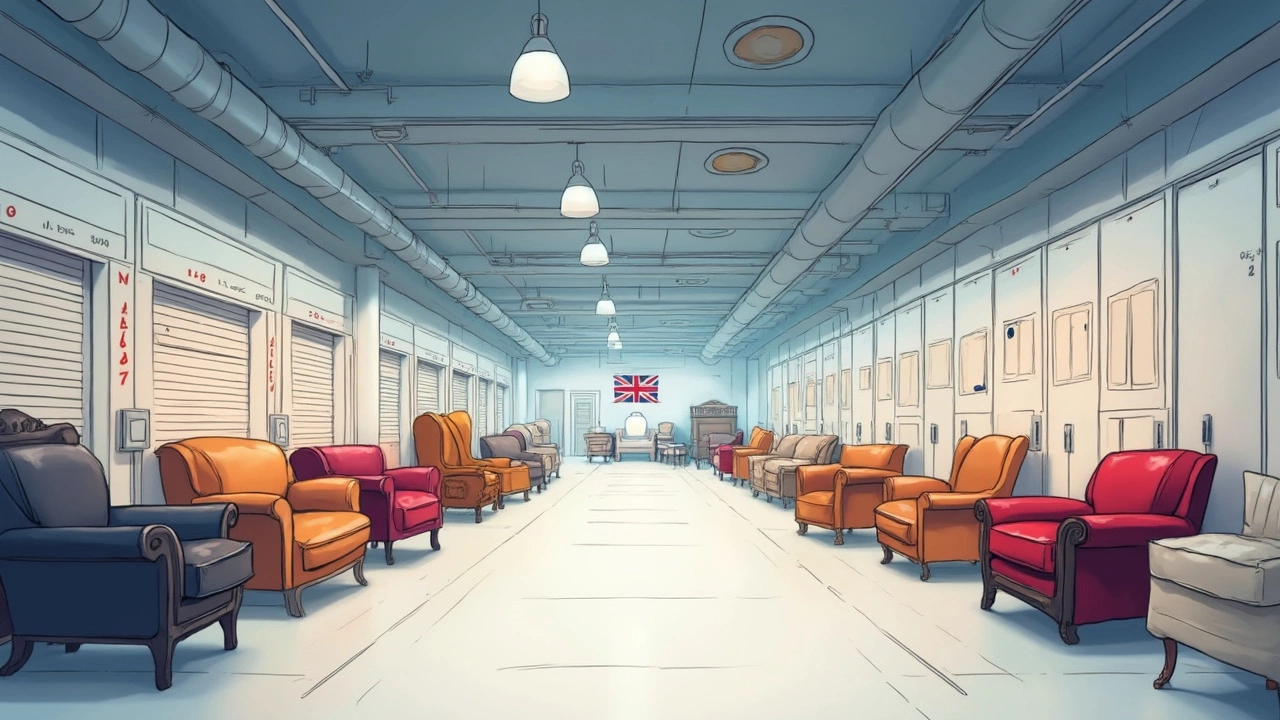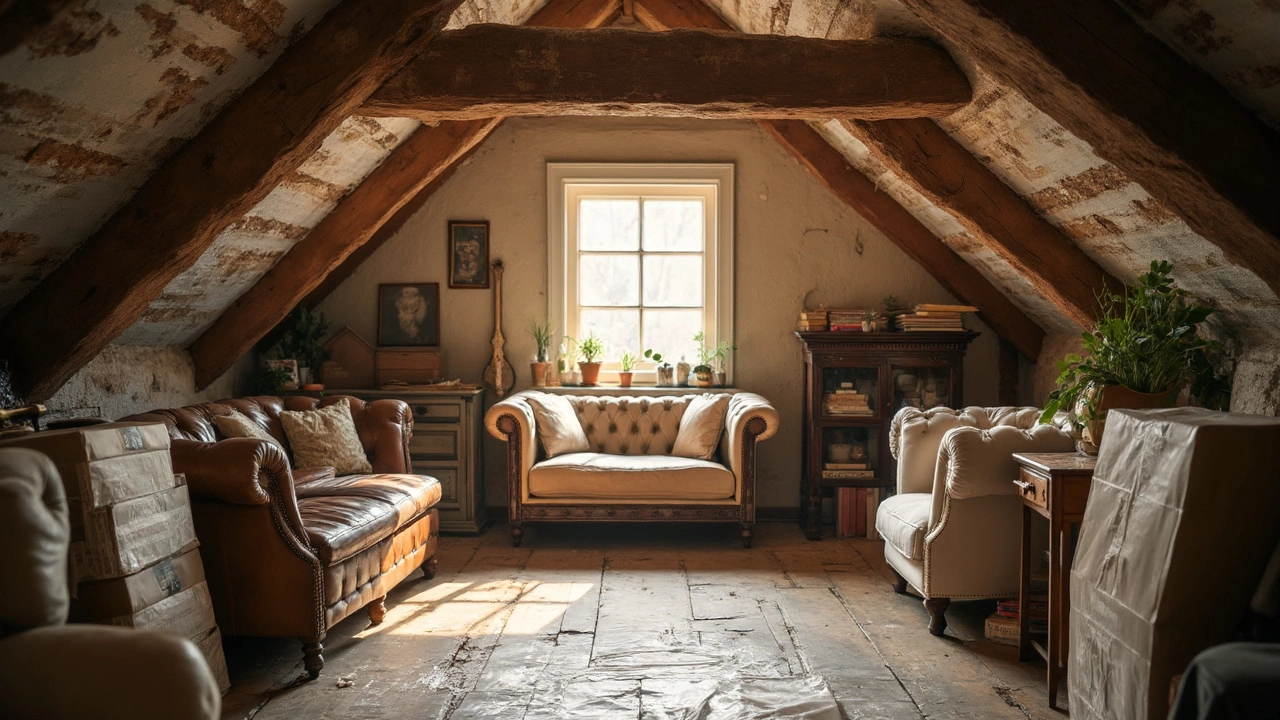When it comes to storing furniture, the first thing to think about is where you're putting it. The right storage space makes all the difference. Look for a spot that's dry and clean—moisture is your furniture's worst enemy. You might want to consider a climate-controlled unit if you're storing valuable items. It keeps things at a steady temperature and humidity level, which is crucial for preserving wood and fabrics.
Next up, let's talk about prepping your furniture for storage. Don't just dump everything in a heap and call it a day. Clean and dry each piece thoroughly before it goes in. Dust, dirt, and liquids can cause serious damage over time. Disassemble items if you can—take legs off tables and remove cushions from sofas. It saves space and makes moving them a breeze.
- Choosing the Right Storage Space
- Preparing Furniture for Storage
- Ensuring Furniture Stays Protected
- Maximizing Space and Accessibility
Choosing the Right Storage Space
Deciding on the right place to store your furniture is a big deal. It's not just about finding a hole to stuff your belongings; it's about finding a home that’ll treat them well. Let's break it down.
Consider Storage Conditions
The local storage facility may look fine on the outside, but what's going on inside? A climate-controlled unit is your best friend when it comes to maintaining the integrity of your items. Extreme temperatures or humidity can warp wood and cause mold in fabrics. Who wants to come back to a mildewy couch? Check if the location offers climate control before you sign anything.
Furniture storage isn't just about temperature, though. Security also takes top priority. Ensure the facility has ample security measures like cameras and coded access. A good security system can determine whether your stuff comes out the same way it went in.
Distance and Accessibility
You might think cheaper is better, but a distant storage unit might not be the best pick if you need frequent access to your belongings. Weigh the cost savings against the potential hassle of a long drive every time you need something.
When it comes to accessibility, find out about their access hours—24-hour access might be convenient if you're a night owl or have unpredictable schedules. Otherwise, regular business hours might suffice.
Type and Size of Unit
How much space do you need for furniture storage? Calculate your needs carefully. You don't want to pay for extra space you'll never use, but cramming pieces into a tight spot can lead to scratches and damages. Sometimes, a little more space can save you a lot of grief down the road.
To give you a rough idea, here's a simple table that might help you gauge the storage unit size:
| Living Space | Recommended Storage Unit Size |
|---|---|
| Studio Apartment | 5x10 ft |
| One-Bedroom Apartment | 10x10 ft |
| Two-Bedroom Home | 10x15 ft |
| Three-Bedroom Home | 10x20 ft |
With all this in mind, choosing the ideal storage spot requires a bit of homework. But the payoff is peace of mind, knowing that your furniture is resting safely until you're ready to use it again.
Preparing Furniture for Storage
Before you start stacking tables and chairs into a storage unit, take a few steps to prep your pieces right. This is where you protect your investment—whether it's the dining room set you splurged on or Grandma's old rocking chair.
Clean Thoroughly
Dirt and stains can morph into permanent blemishes if left on furniture in storage. Wipe down wood, metal, and plastic items with a soft cloth and water or a mild cleaner. For upholstered furniture, consider vacuuming and possibly using a steam cleaner to get rid of any trapped dust and allergens.
Disassemble When Possible
This is a game-changer. If your furniture can be taken apart, do it. Remove legs from tables, take cushions off sofas, and dismantle bed frames. It makes transportation a snap and gives you more room in your storage unit. Make sure to keep screws and small parts in labeled bags. You don't want to play detective when it's time to reassemble.
Protect Fragile Surfaces
Use furniture covers, or even old sheets and blankets, to shield your pieces from dust and scratches. Wrap delicate items like glass tabletops with bubble wrap or padded blankets. This one step can save you from heartbreak when you're unpacking later.
Use Appropriate Packaging Materials
Avoid using plastic covers for extended storage since they trap in moisture, which can lead to mold and mildew—especially bad for wood and fabric. Instead, breathable materials like cloth covers are your best bet.
Label Everything
Sounds basic, but labeling goes a long way. Knowing what's wrapped up without unwrapping can save you a headache when you're searching for something specific. If you've removed parts from disassembled furniture, clearly label these, too.
Taking a bit of time to prepare your items for storage not only preserves their condition but also makes it easier when you're ready to bring them back into action. It's not just about tossing everything into a unit; it's about being smart with your furniture storage choices.

Ensuring Furniture Stays Protected
Once your furniture is in storage, ensuring it stays protected is key to keeping it in top shape. It might seem unnecessary, but covering your items is crucial. Use old sheets, drop cloths, or specialized furniture covers to shield them from dust and dirt. Avoid thick plastic as it can trap moisture, leading to mildew, which is every furniture owner's nightmare.
Mind the Stack
When it comes to stacking furniture, be cautious. Avoid stacking heavy items on top of delicate pieces. Use a sturdy base and work your way up, placing lighter items on top. This simple trick helps prevent dents and scratches during prolonged storage periods.
Use Pallets or Blocks
Make sure to raise furniture off the ground using pallets or blocks. This can prevent moisture damage if there's a minor flood or spill. Being elevated allows air to circulate more freely around your furniture, making sure it stays dry.
Periodic Check-ups
Don't just lock the storage unit and forget about it. Periodically checking in on your stored items allows you to catch any issues early, like pest infestations or signs of damage. Schedule a visit every couple of months just to ensure everything is still in good condition.
By taking these steps, your stored furniture stays safe and sound, and ready for use whenever you need it again.
Maximizing Space and Accessibility
When you're storing furniture, it's not just about cramming everything in; you want to make sure you can easily access what you need without a game of Tetris every time. Smart placement is the key.
Use Vertical Space
Make good use of vertical space. Stack furniture items if possible, but ensure heavier pieces are on the bottom to avoid accidents. Consider sturdy shelving units for smaller items like lamps and cushions—this not only saves floor space but also keeps things organized. According to Susan Lynn, a professional organizer, "The goal is to make accessing and storing items as hassle-free as possible."
Label Everything
Before tucking things away, label boxes and bags. Trust us, labels are lifesavers when you need to grab something quickly. Labeling will also help you remember where everything is when you need to unpack later.
Create Pathways
Creating pathways might sound strange, but it's crucial. When filling your storage space, leave room to walk through. This way, you can reach items without having to move everything else. If you're using a larger space, think about leaving a clear path to the back.
Consider Furniture Covers
Using covers on your furniture not only protects them but also makes it easier to stack items. Covers can protect against scratches and dust, especially if you're using a non-climate-controlled unit.
Here's a simple breakdown of typical steps people take when trying to maximize space:
- Disassemble larger pieces to save space.
- Wrap furniture in protective coverings.
- Number and label disassembled parts for easy reassembly.
- Create a layout or map before starting to load your storage space.
Utilizing these strategies, you'll not only store your furniture efficiently but make future access simple. Remember, organization upfront saves headaches down the road. It's all about being smart now so that life is easier later.


Write a comment